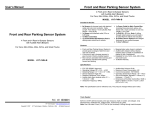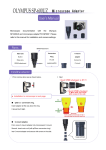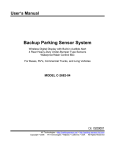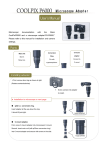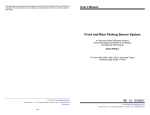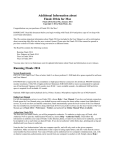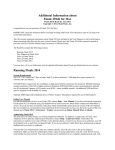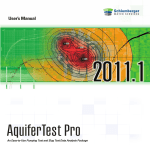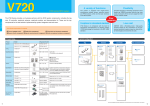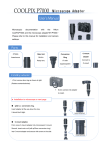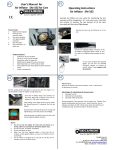Download User`s Manual Front and Rear Parking Sensor System
Transcript
User’s Manual Front and Rear Parking Sensor System 4 Front and 4 Rear In-Bumper Sensors Wired Digital Distance Display with Built-in Audible Alert For Cars, Mini-VANs, SUVs, and Small Trucks MODEL B-2661-08 CE ISO9001 HY Technologies y http://parkingsensors.net y http://parking-sensors.hyt.com Copyright 8 2006 HY Technologies y Milpitas y California y USA All Rights Reserved Front and Rear Parking Sensor System 4 Front and 4 Rear In-Bumper Sensors Wired Digital Distance Display with Built-in Audible Alert For Cars, Mini-VANs, SUVs, and Small Trucks MODEL B-2661-08 Included in the Box ¾ 8x Sensors (in-bumper type) with attached cable and 2-pin mini connector. Cable Length: Front Sensor = 8.0m (26.2'); Rear Sensor = 2.5m (8.2') ¾ 1x Digital Distance Display with built-in beeper, On/Off switch, and earphone type plug with attached cable (6m or 19.7' long) ¾ 1x Main Control Box with 2 double-sided self-adhesive and Velcro attachment pads. ¾ 1x System Bus Cable (0.78m or 2.6' long) with 12-pin connector on one end, a black and a red socket on the other end. ¾ 1x Power Supply Wire for Main Control Box - red wire with red plug on one end. Cable Length: 6.0m (19.7') ¾ 1x Signal Control Cable including three wires (red, white, and black) and a 3-pin connector on one end. Length: 0.78m (2.6') ¾ 1x Drill Bit - Φ21mm. Note: if drilling through metal bumpers, you will need a bi-metal Φ21mm drill bit (not included). ¾ 8x Plastic Rings with wedged thickness ¾ 1 Bag of Cable Ties (15 pieces) ¾ 1x User’s Manual Features ¾ Front and Rear Parking Sensor System to provide good coverage of both front and rear end of vehicle ¾ 4 front and 4 rear in-bumper sensors to give the look of factory installed system ¾ Rear sensors are activated while reversing and front sensors are activated while driving forward and braking ¾ Wired Digital Distance Display with Built-in Audible Alert (Beeper) with On/Off Switch ¾ Seven (7) LED Lights on each side of the distance display to indicate both orientation of obstacles and Safe/Warning/Stop zone. ¾ Distance display in meters ¾ Designed for cars, SUVs, Mini-VANs, and small trucks ¾ 12 Month Warranty Specifications ¾ Operating Voltage: DC 10.5 ~ 16V ¾ Detecting Range: Front 0.2 ~ 1.5m (0.66 ~ 4.9'); Rear 0.2 ~ 1.5m (0.66 ~ 4.9'). ¾ Measuring Error: ± 0.1m (0.3') ¾ Sensor Detection Angle: 90° ¾ Detection Response Time: 300ms ¾ Audible Alert when obstacle within: 0.1 ~ 1.5m (0.3 ~ 4.9') ¾ Ultrasonic Frequency: 40Khz Audible Alert Volume: 60 db Maximum Power Consumption: 4W Current Consumption: 100~300mA Operating Temperature Range: -30 ~ +70°C Dimensions of the LED Display: Width x Depth x Height = 10.0cm x 3.0cm x 2.0cm (3.9" x 1.2" x 0.8") ¾ Dimensions of the Main Control Box: Width x Depth x Height = 10.5cm x 7.3cm x 2.1cm (4.1" x 2.9" x 0.8") ¾ Distance display in meters ¾ ¾ ¾ ¾ ¾ Note: The specifications are for reference only. They may be changed without prior notice. Tools Needed Φ21mm drill bit (include), drill, tape measure, chalk or marker, wire stripper, vinyl electrical tape, cable/wire ties, voltage meter, screw driver set, pliers. Note: Use a bi-metal 21mm drill bit (not included) if drilling through metal bumpers. -1- How the System Works The Parking Sensor System determines obstacle distance by measuring the time needed for the ultrasonic wave emitted by a sensor to reach an obstacle and for the sensor to receive the ultrasonic wave reflected from the obstacle. Given the speed of the ultrasonic wave, the system can then calculate and display the distance between the sensor and the obstacle. To provide good coverage of both front and rear end of vehicle, the system comes with 8 sensors (4 front and 4 rear sensors). To have the look of factory installed system, the 8 sensors are in-bumper type (to be installed in the front and rear bumpers by drilling holes through the bumpers). The main control box and display get their power by tapping into the ignition switch or ACC wires so that the system will work only when the engine is started or ACC is on. Controlled by the +12V from the back up light, the rear sensors are activated when the vehicle is put in reverse. Controlled by both the +12V from the brake and the 0V from the back up light (no +12V applied to the back up lights when in forward driving), the front sensors are activated when the brake is applied and the vehicle is in forward driving. It is supplied with a wired digital distance display which shows the exact distance from an obstacle in front or rear of the vehicle. Seven (7) LED Lights (Green/Yellow/Red) on each side of the distance display indicate both orientation of obstacles and Safe/Warning/Stop zone. The audible alert (beeper) is built in the display with volume On/Off switch. It beeps faster as vehicle gets closer to obstacle and sounds continuously when vehicle is within 0.4m (1.3ft) from the obstacle. H Gr L1 L2 L3 L4 L1 Fig.1 Mounting Height and Position of 4 Rear Sensors H = 50 ~ 80cm (20” ~ 32”) L1 = 6 ~ 15cm (2” ~ 6”) L2 = L3 = L4 or L2 = L4 = 0.3L, L3 = 0.4L 2 Fig. 3 Main Control Box and Display Wiring -2- Installation and Wiring IMPORTANT: (a) Read this manual thoroughly before proceeding to installation. You can also have the system installed by a professional installer such as your local auto mechanic/auto electrician/car stereo store. (b) Turn off the engine and ACC during installation. (c) Double check that all wiring is correct before power on the system. (d) During installation, avoid flatting, perforating, cutting, and extending the wires of sensors to reduce unnecessary signal loss. 1. Installation of the Main Control Box a) Find a flat and clean surface for the main control box inside the vehicle close to driver's side taillight assembly. For trucks, you may install it inside the driver's side taillight assembly. Keep it away from areas of high heat, high humidity, direct water contact, direct sunlight, and electromagnetic devices. b) Place the main control box in place temporarily without securing it to the vehicle as you may need to adjust the location of the main control box while wiring. Note: After completing all wiring, use the double-sided self-adhesive with Velcro attachment included to secure it to the vehicle. c) Insert the 12-pin plug of the system bus cable into its 12-pin socket labeled "BUS" on the side of the main control box (Fig. 3). d) Insert the 3-pin plug of the signal control cable into its 3-pin socket labeled "SIGNAL" on the side of the main control box (Fig. 3). 2. Wiring the Main Control Box a) Locate the +12V and the (-) negative wires from the back up light near the taillight assembly. b) Locate the +12V wire from the brake light near the taillight assembly. If necessary, remove the taillight assembly to locate them. Strip 1/2" of the wires. c) Connect the red wire of the signal control cable to the +12V wire of the back up light (Fig. 3). d) Connect the white wire of the signal control cable to the (-) negative wire of the back up light. e) Connect the black wire of the signal control cable to the +12V wire of the brake light. f) Wrap all connections with vinyl electrical tape. g) Locate the wire of the ignition switch "ON Block" under the dashboard. Strip 1/2" of the wire. h) Connect the red power supply wire of the main control box to it. Note: You can also connect the red power wire to ACC. But connecting it to the ignition switch "ON Block" is preferred as the system only needs to work when the engine is started. i) Wrap the connection with vinyl electrical tape. j) Run the red power wire from the ignition switch down to the floor, and then to the main control box in the back of the vehicle (hide the wire under the door or weather trim). k) Firmly insert the red plug into its red socket on the end of the system bus cable you inserted into the main control box in Step.1 (c). Screw on the red threaded sleeve to lock the connection. 3. Installation of the Digital Distance Display a) Find a place for the display on top of the dashboard where the driver can see it easily. Place the display in place temporarily without securing it to the top of the dashboard. Note: After completing all wiring, secure it with the included self-adhesive on the bottom of the display. b) Run the display wire from the top of the dashboard down to the floor, and then to the main control box in the back of the vehicle (hide the wire under the door or weather trim). c) Insert the black earphone type plug of the display into its black socket on the end of the system bus cable which you inserted into the main control box in Step.1 (c). 4. Installation of the Sensors IMPORTANT: (a) To avoid false alert from the system detecting the ground, the sensors should be mounted between 50cm to 80cm (20" to 32") above the ground and the face of the sensors need to be vertical or slightly upward angled (Fig.4). (b) Horizontally, the sensors should be equally spaced if possible or symmetric to the center of the bumper. (c) The outer two sensors should be mounted about 15cm (5.9") from the corner of the bumper for better corner coverage. Note: The bumper surface for mounting the sensors should be as flat and vertical as possible. a) Start with the front sensors, and then the rear sensors. Refer to Fig. 1 and 2 for mounting height and position of the front and rear sensors. -3- b) Work under the front and rear bumpers to check the internal structure of them before marking the positions for drilling holes. If the view is blocked, you may need to remove the bumpers. c) With chalk or marker, mark the position of sensors on the bumpers. Make sure that the sensors can be pushed all the way in and that you can feed the wires through. d) Drill the holes through the bumpers at the marks with the Φ21mm drill bit included. Note: if drilling through metal bumper, you will need a bi-metal Φ21mm drill bit (not included). e) If necessary, smooth the sharp edge of the holes with a polishing head or small round file. f) Run the sensor wires into the holes drilled. Push the sensors into the holes. When pushing the sensors only apply pressure at the edges, not on the middle of the sensor to avoid damage to the sensor element. The sensors are tapered for a snug fit. g) Adjust the sensors for non-vertical bumper surface by using/rotating the plastic rings with wedged thickness included. h) For front sensors, run the sensor wires from the front bumper into the inside of the vehicle through the existing wiring holes or rubber grommet in the fire wall, and then to the main control box in the back of the vehicle (hide the wire under the door or weather trim). i) For rear sensors, run the sensor wires from the rear bumper into the trunk or inside of the vehicle through the existing small vent or rubber grommet in the rear of the trunk or vehicle, and to the main control box. Note: Do not cut the sensor wires. j) Attach sensor wires to the vehicle body with cable/wire ties so that they will not get in the way of any moving parts and there are no loose wires hanging down. k) Plug all sensors into their corresponding sockets at the main control box. Testing Your New Parking Sensor System For the rear sensors, back your vehicle slowly (about 3 miles per hour) to approximately 1.5m (4.9 feet) from a flat vertical surface such as a wall. Continue to back up slowly and check the performance against Chart 1. For the front sensors, do the same test while driving forward slowly and braking. The front sensors will work for 10 more seconds after the brake is released. Using the Display The display has a built-in beeper (audible alert) with On/Off Switch. There are seven (7) LED Lights (2 Green, 3 Yellow, 2 Red) on each side of the two-digit distance display (Fig. 3). The color LED lights indicate both orientation of obstacle and Safe/Warning/Stop zone (Chart. 1). Chart 1. Orientation of Obstacle, Digital Distance Display, and Beeping (Audible Alert) Viewing from the Front of the Display Obstacle Distance LEDs on the Left Side of the Display Responding to Rear Sensor 1, 2 or Front Sensor 5, 6 (Fig. 1, 2, 3) Beeping Digital Distance Display LEDs on the Right Side of the Display Responding to Rear Sensor 3, 4 or Front Sensor 7, 8 (Fig. 1, 2, 3) Safe Zone No LEDs on (> 1.3m) No Safe Zone 2 Green on (1.3~1.0m) Starting to Actual beep at 1.3m distance 2 Green on Warning 3 Yellow, 2 Green on Zone (1.0~0.5m) Fast to Faster Actual distance 3 Yellow, 2 Green on Stop Zone 1 Red, 3 Yellow, 2 Green on (0.5~0.4m) Fastest Actual distance 1 Red, 3 Yellow, 2 Green on Stop Zone 2 Red, 3 Yellow, 2 Green on & (0.4~0.0m) flashing Continuously 0.0 ... -4- No LEDs on 2 Red, 3 Yellow, 2 Green on & flashing Warning z To avoid collision with obstacle because of the inertia of vehicle while backing up/parking, keep your vehicle speed at about 3 miles per hour and stop the vehicle immediately once you hear the continuous beeping. This is because even if you have applied brake, your vehicle will still go for some distance (inertia) before it comes to a complete stop. z Because the back up parking system detects obstacle by emitting ultrasonic wave and receiving reflected ultrasonic wave from obstacle, the system may fail to give both visual and audible alert if an obstacle has smooth ball-shaped or sloped surfaces as such surfaces may not reflect ultrasonic wave back to the sensors. Drivers in these situations should pay more attention while parking their vehicles. z In heavy falling rain or snow, the system may give alert as falling rain or snow may be detected as obstacles. Keep surface of sensors clean of snow, mud, dirt, and other debris. Troubleshooting Problem Cause Solution Display doesn't light up when reversing or forwarding with braking No power to the display. No power to the main control box. Faulty display. Check display power connection. Check main control box power connection. Replace the display. Contact Technical Support for help. Display light up but system is not detecting any obstacle Sensors not connected. Faulty display. Faulty main control box. Check sensor connections. Replace the display. Replace the main control box. Contact Technical Support for help. System showing distance but no beeping or system beeping but no distance display Beeper turned off. Faulty display. Faulty main control box. Turn on beeper. Replace the display. Replace the Main Control Box. Contact Technical Support for help. System is not detecting any obstacle in front No control signal from brake. Check main control box connection to +12V from brake. System is not detecting any obstacle in rear No control signal from back up light. Check main control box connection to +12V from back up light. Wrong LEDs light up Sensors are plugged into the wrong sockets at the main control box Install the sensors in the bumper as labeled in Fig. 1 & 2 and plug sensors as labeled on the sensor wires into their corresponding sockets at the main control box (Fig. 3) Display constantly shows 0.0 Object within 0.40m is detected or beeps continuously Display shows a distance and beeps even there is no obstacle behind Ground is detected. Sensors angle is low. Sensors installed too low (mounting height below 0.5m) Unplug all sensors, and then plug back in one sensor at a time to find out which sensor is causing the problem. Adjust angle of the sensor. Refer to 4. Installation of the Sensors for details. Unplug all sensors, and then plug back in one sensor at a time to find out which sensor is causing the problem. Adjust angle of the sensor. Refer to 4. Installation of the Sensors for details. For more installation related questions and Frequently Asked Questions (FAQs) with answers, and product photos, visit our Web site at http://parkingsensors.net or http://parking-sensors.hyt.com -5- IMPORTANT The Parking Sensor Systems sold and distributed by HY Technologies are only a device used to assist a driver while parking. They should not be considered as a substitute for driver responsibility when operating a vehicle. No warranty as to operational efficiency is granted. We don't guarantee or assume liability for collisions or damages that take place when parking your vehicle with the use of the Parking Sensor System. We will not be liable for any claims, actions, suit proceedings, costs, expenses, damages or liabilities arising out of the use of this product. By purchasing, installing and using such a Parking Sensor System, customers agree to take full responsibility of use of such System. HY Technologies y http://parkingsensors.net y http://parking-sensors.hyt.com Copyright 8 2006 HY Technologies y Milpitas y California y USA All Rights Reserved -6-







